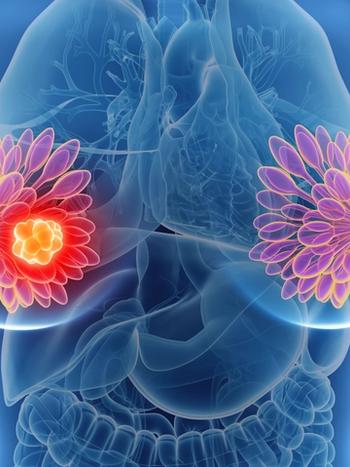
Subgroups of Women with Breast Cancer May Be at Higher Risk for Chronic Controlled Substance Use After Surgery
Women who were younger, diagnosed with breast cancer, and received chemotherapy were reported to have a higher risk of new chronic controlled substance use following mastectomy with reconstruction.
Women diagnosed with breast cancer who were younger and received chemotherapy appeared to be at an increased risk of becoming a new persistent user of chronic controlled substance use following mastectomy with reconstruction, according to study results presented at the 2020 San Antonio Breast Cancer Symposium.
Moreover, the findings highlight the fact that more attention is needed for patients with mental health diagnoses and substance use diagnoses when managing pain, anxiety and sleep disorders.
Chronic opioid use after surgery has increased, with up to 10% of patients continuing to fill opioid prescriptions beyond three months after surgery, according to the researchers. However, previous studies have not evaluated post-operative opioid use in those diagnosed with cancer, versus those without a cancer diagnosis; as well as if a similar pattern of chronic opioid use exists regarding the use of benzodiazepines and other non-benzodiazepine sedative/hypnotics are used after mastectomy and reconstructive surgery.
“Despite the high rates of psychiatric disorders in the cancer population, there is little research into the rates of persistent sedative/hypnotic use in these cases,” lead author of the study Jacob Cogan, MD, a fellow in hematology/oncology at NewYork-Presbyterian/Columbia University Irving Medical Center in New York, said during a press briefing.
Therefore, the researchers aimed to determine the rates of new persistent controlled substance use following mastectomy with reconstructive surgery, and to determine predictors of developing new persistent controlled substance use after surgery.
They evaluated women >18 years of age who underwent mastectomy plus reconstruction between 2008-2017 using the MarketScan healthcare claims database – which included administrative claims from 230 million unique patients, as well as inpatient, outpatient and prescription claims, and Medicaid, Medicare and employer-based insurances.
Prescriptions for opioids and sedative-hypnotic drugs were identified during 3 time periods:
- pre-operative (365 days to 31 days prior to surgery; period 1);
- peri-operative (31 days prior to 90 days after their surgery; period 2), and
- post-operative (90 days to 365 days after surgery; period 3).
Patients who filled at least 1 prescription for controlled substances during period 1 were excluded from the study analysis. Those who did not use controlled substances during period 1 but filled at least 1 prescription in period 2 and at least 2 prescriptions in period 3 were considered new chronic users and were compared to the other non-chronic users.
The researchers conducted a separate multivariable logistic regression analysis to evaluate demographic and clinical factors associated with risk of chronic use for each drug category, including age, insurance, region, breast cancer diagnosis, chemotherapy treatment, radiation treatment, prior mental health diagnosis, and prior substance use diagnosis.
In total, the researchers identified 25,270 women who were opioid-naïve and 27,651 who were sedative-hypnotic naïve.
Within each group, 13.1% of opioid-naïve patients became new chronic users and 6.6% of those in the sedative-hypnotic naïve group became new persistent users.
The researchers then removed non-user patients who never received or filled their perioperative prescriptions. In turn, these rates for opioid-naïve (n = 18,931) and sedative-hypnotic naïve (n = 10,781) patients rose to 17.5% and 17.0%, respectively.
The researchers saw higher rates of opioid use in younger patients (under age 60), those with Medicaid insurance (OR, 1.37; 95% CI, 1.11-1.68; P = .003), those with a breast cancer diagnosis (OR, 1.45; 95% CI, 1.04-2.02; P = .03), those treated with chemotherapy (OR, 1.35; 95% CI, 1.25-1.46; P < .0001), those with mental health diagnoses (OR, 1.66; 95% CI, 1.54-1.79; P < .0001), and those with substance use diagnoses (OR, 1.93 95% CI, 1.64-2.26; P < .0001).
Moreover, the researchers found that a patient’s risk for becoming a new persistent user increased with the number of risk factors identified. For example, those with 5 risk factors (age, Medicaid, Southern region, breast cancer diagnosis, and chemotherapy/radiation treatment), demonstrated an odds ratio of 6.34 (19%) of becoming a new persistent user of opioids and 7.71 (10.5%) of becoming a new persistent user of sedatives/hypnotics.
Commenting on the study, former AACR president Carlos Arteaga, MD, FAACR, from Southwestern Medical Center, noted that a lot of this information is known, but not all of it. “I wonder if you can tell us which are the types of patients that we might not be paying attention to, that this study is telling you to be particularly aware of for this risk of substance abuse?”
In response, Cogan explained that the risk factors found in the study spark particular attention for certain patients. “It raises the issue that, as a provider, when you’re seeing patients in follow-up, this is something you might want to explicitly ask about, and not assume that the post-operative opioids were taken and disposed of after,” he said. “Ask the patient, ‘Are you still taking opioids? Are you still taking your Ambien?’ If someone is still taking it, that’s something to diligently follow up about and make sure it’s disposed of. Or if someone is still taking it, refer them to the right services to raise a flag across the board as something we should routinely pay attention to post-operatively.”
Reference:
Cogan JC, Raghunathan RR, Beauchemin MP, et al. Persistent controlled substance use following mastectomy with reconstruction surgery. Presented at: 2020 San Antonio Breast Cancer Symposium; December 8, 2020; Virtual. Abstract GS3-08.
Newsletter
Stay up to date on recent advances in the multidisciplinary approach to cancer.

























































































